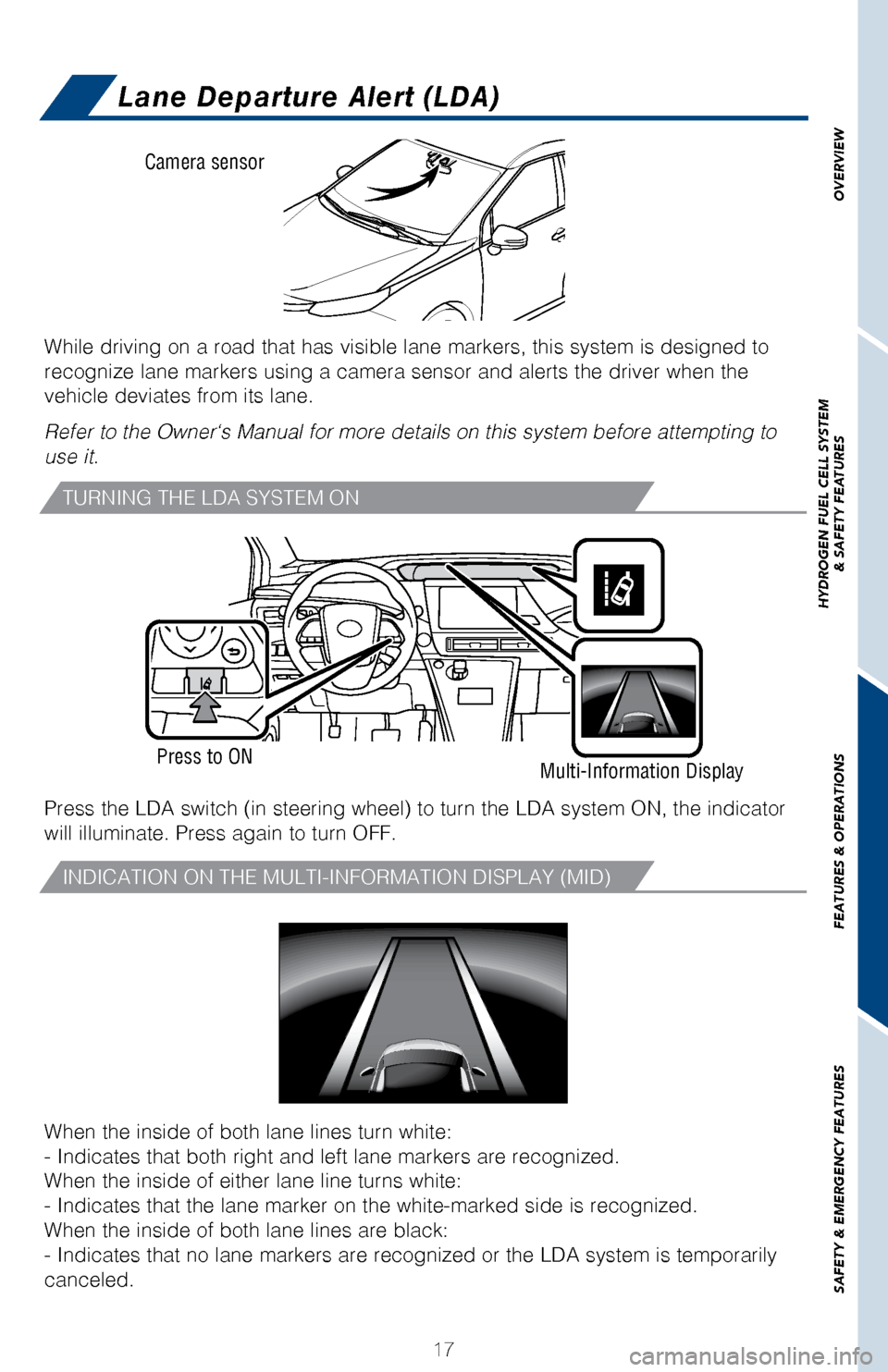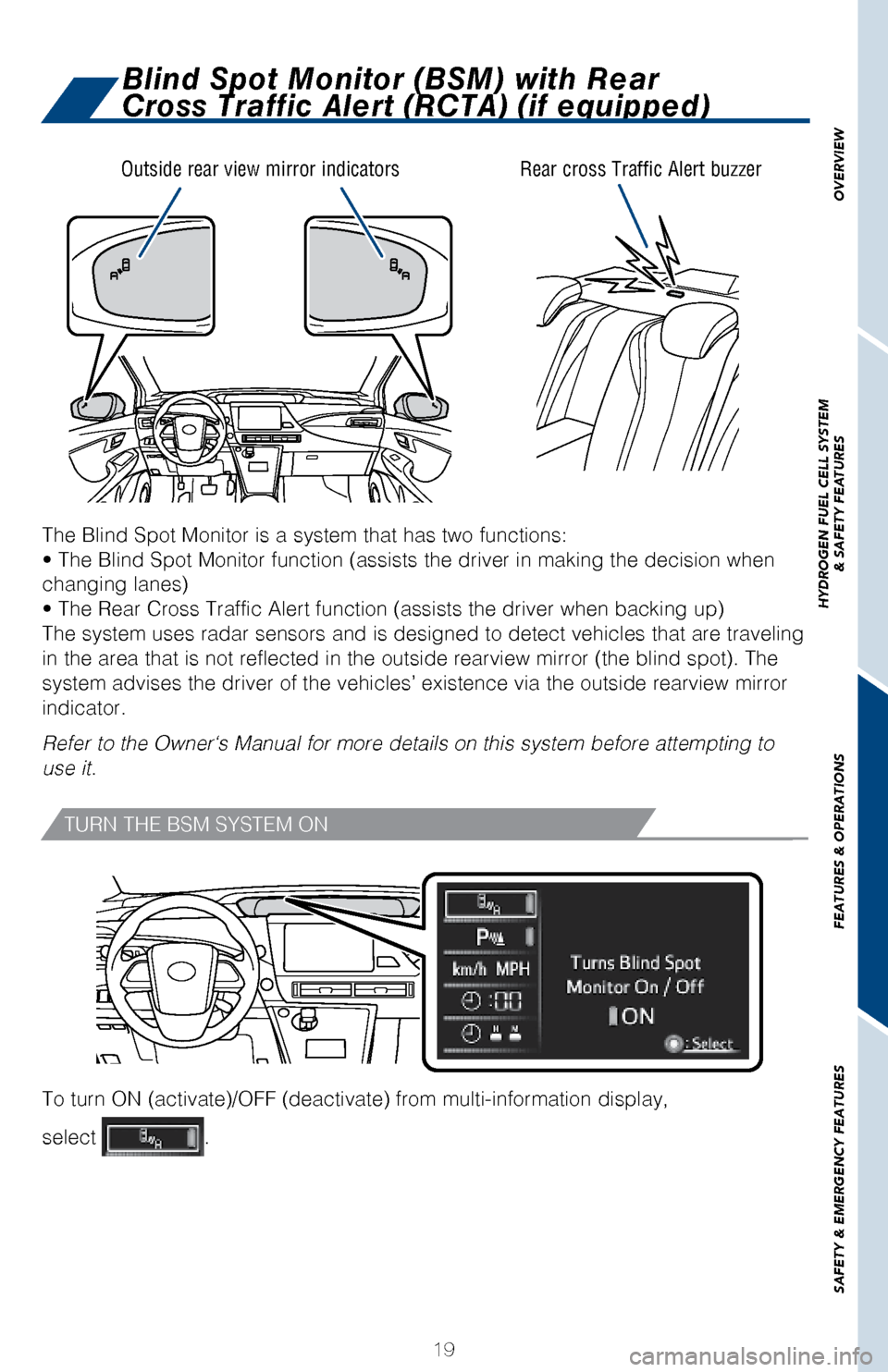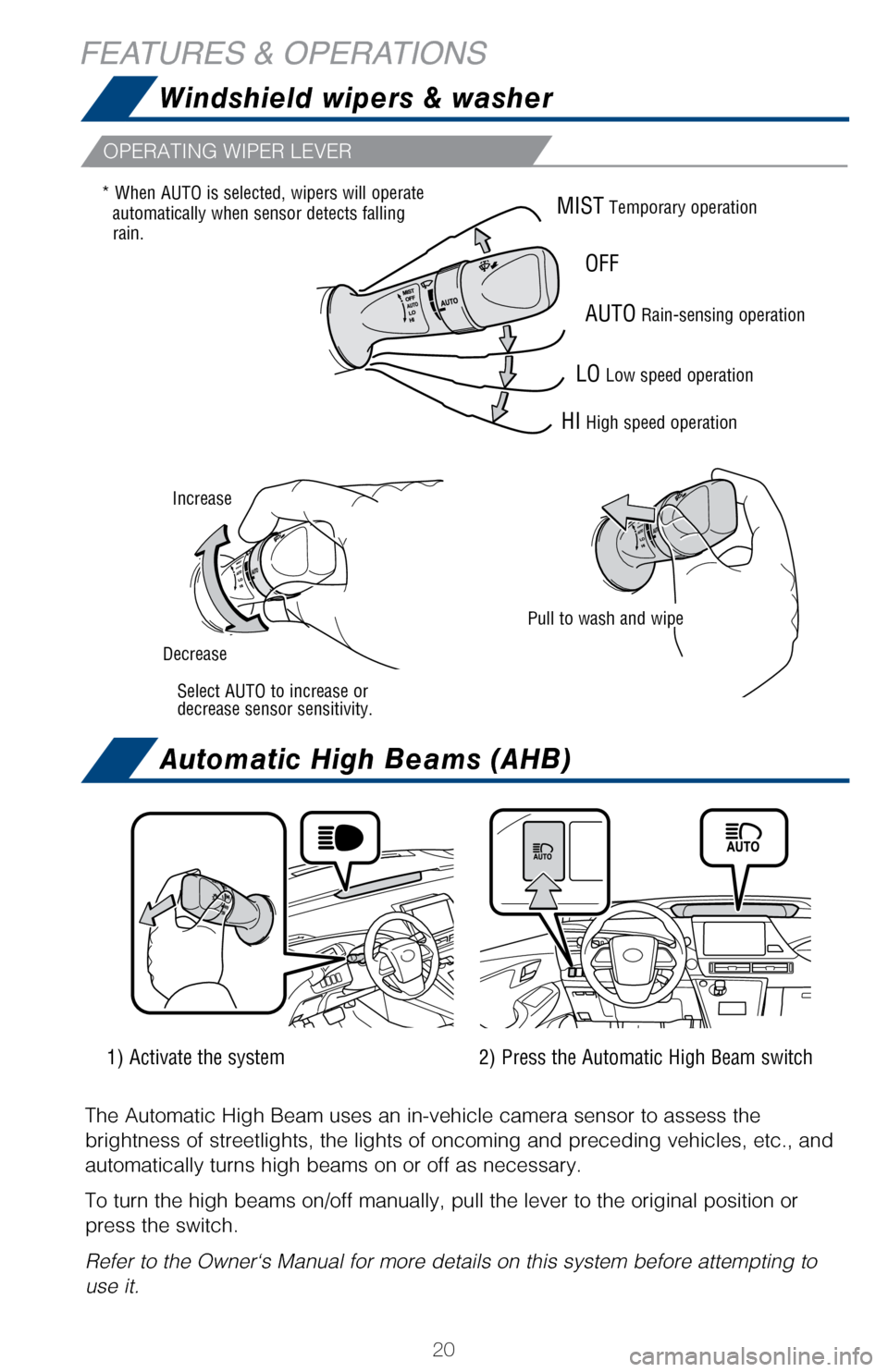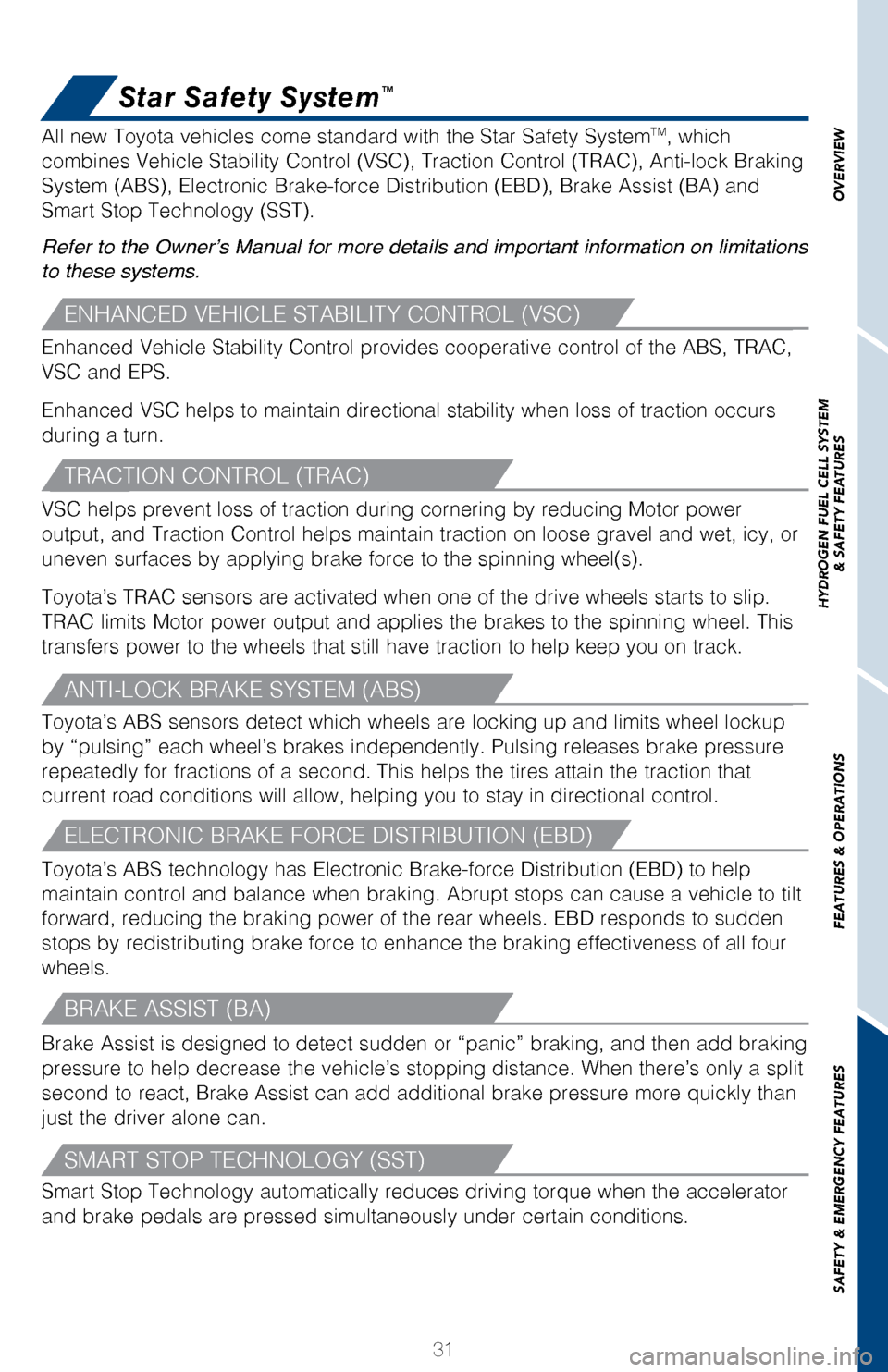sensor TOYOTA MIRAI 2017 1.G Quick Reference Guide
[x] Cancel search | Manufacturer: TOYOTA, Model Year: 2017, Model line: MIRAI, Model: TOYOTA MIRAI 2017 1.GPages: 42, PDF Size: 8.18 MB
Page 19 of 42

OVERVIEW
HYDROGEN FUEL CELL SYSTEM
& SAFETY FEATURES
FEATURES & OPERATIONS
SAFETY & EMERGENCY FEATURES
17
Lane Departure Alert (LDA)
While driving on a road that has visible lane markers, this system is de\
signed to
recognize lane markers using a camera sensor and alerts the driver when \
the
vehicle deviates from its lane.
Refer to the Owner‘s Manual for more details on this system before at\
tempting to
use it.
Press the LDA switch (in steering wheel) to turn the LDA system ON, th\
e indicator
will illuminate. Press again to turn OFF.
When the inside of both lane lines turn white:
- Indicates that both right and left lane markers are recognized.
When the inside of either lane line turns white:
- Indicates that the lane marker on the white-marked side is recognized.\
When the inside of both lane lines are black:
- Indicates that no lane markers are recognized or the LDA system is tem\
porarily
canceled.
Camera sensor
Press to ON Multi-Information Display
TURNING THE LDA SYSTEM ON
INDICATION ON THE MULTI-INFORMATION DISPLAY (MID)
Page 20 of 42

18
FEATURES & OPERATIONS
Pre-Collision System (PCS)
When a high possibility of a frontal collision is detected by the radar \
sensor, a
buzzer sounds and a message urging the driver to take evasive action app\
ears on
the multi-information display. If the driver then applies brakes, the s\
ystem applies
greater brake force in relation to how strongly the brake pedal is depre\
ssed. If
the system determines that a collision is unavoidable, the brakes are au\
tomatically
applied to reduce the collision speed. The system is enabled each time t\
he power
switch is turned to ON mode.
Refer to the Owner‘s Manual for more details on this system before at\
tempting to
use it.Each time the Pre-Collision System switch is pressed, the response to th\
e distance
changes as follows:
Press the PCS switch for 3 seconds or more.
Far
Near
Middle
(default setting)
CHANGING THE PRE-COLLISION WARNING TIMING
DISABLING THE PRE-COLLISION SYSTEM
Page 21 of 42

OVERVIEW
HYDROGEN FUEL CELL SYSTEM
& SAFETY FEATURES
FEATURES & OPERATIONS
SAFETY & EMERGENCY FEATURES
19
Blind Spot Monitor (BSM) with Rear
Cross Traffic Alert (RCTA) (if equipped)
The Blind Spot Monitor is a system that has two functions:
• The Blind Spot Monitor function (assists the driver in making the \
decision when
changing lanes)
• The Rear Cross Traffic Alert function (assists the driver when bac\
king up)
The system uses radar sensors and is designed to detect vehicles that ar\
e traveling
in the area that is not reflected in the outside rearview mirror (the b\
lind spot). The
system advises the driver of the vehicles’ existence via the outside \
rearview mirror
indicator.
Refer to the Owner‘s Manual for more details on this system before at\
tempting to
use it.
To turn ON (activate)/OFF (deactivate) from multi-information displa\
y,
select
.
Outside rear view mirror indicators
Rear cross Traffic Alert buzzer
TURN THE BSM SYSTEM ON
Page 22 of 42

20
FEATURES & OPERATIONS
OPERATING WIPER LEVER
MIST Temporary operation
AUTO Rain-sensing operation
LO Low speed operation
HI High speed operation
OFF
Pull to wash and wipe
Select AUTO to increase or
decrease sensor sensitivity.
* When AUTO is selected, wipers will operate
automatically when sensor detects falling
rain.
Increase
Decrease
Windshield wipers & washer
Automatic High Beams (AHB)
The Automatic High Beam uses an in-vehicle camera sensor to assess the
brightness of streetlights, the lights of oncoming and preceding vehicle\
s, etc., and
automatically turns high beams on or off as necessary.
To turn the high beams on/off manually, pull the lever to the original p\
osition or
press the switch.
Refer to the Owner‘s Manual for more details on this system before at\
tempting to
use it.
1) Activate the system 2) Press the Automatic High Beam switch
Page 33 of 42

31
OVERVIEW
HYDROGEN FUEL CELL SYSTEM
& SAFETY FEATURES
FEATURES & OPERATIONS
SAFETY & EMERGENCY FEATURES
Star Safety System™
Enhanced Vehicle Stability Control provides cooperative control of the A\
BS, TRAC,
VSC and EPS.
Enhanced VSC helps to maintain directional stability when loss of tracti\
on occurs
during a turn.
VSC helps prevent loss of traction during cornering by reducing Motor po\
wer
output, and Traction Control helps maintain traction on loose gravel and\
wet, icy, or
uneven surfaces by applying brake force to the spinning wheel(s).
Toyota’s TRAC sensors are activated when one of the drive wheels star\
ts to slip.
TRAC limits Motor power output and applies the brakes to the spinning wh\
eel. This
transfers power to the wheels that still have traction to help keep you \
on track.
Toyota’s ABS sensors detect which wheels are locking up and limits wh\
eel lockup
by “pulsing” each wheel’s brakes independently. Pulsing release\
s brake pressure
repeatedly for fractions of a second. This helps the tires attain the tr\
action that
current road conditions will allow, helping you to stay in directional c\
ontrol.
Toyota’s ABS technology has Electronic Brake-force Distribution (EBD\
) to help
maintain control and balance when braking. Abrupt stops can cause a vehi\
cle to tilt
forward, reducing the braking power of the rear wheels. EBD responds to \
sudden
stops by redistributing brake force to enhance the braking effectiveness\
of all four
wheels. All new Toyota vehicles come standard with the Star Safety System
TM, which
combines Vehicle Stability Control (VSC), Traction Control (TRAC), Anti-lock Braking
System (ABS), Electronic Brake-force Distribution (EBD), Brake Assis\
t (BA) and
Smart Stop Technology (SST).
Refer to the Owner’s Manual for more details and important information on limitations
to these systems.
Brake Assist (BA)Brake Assist is designed to detect sudden or “panic” braking, and \
then add braking
pressure to help decrease the vehicle’s stopping distance. When there\
’s only a split
second to react, Brake Assist can add additional brake pressure more qui\
ckly than
just the driver alone can.
Smart Stop Technology automatically reduces driving torque when the acce\
lerator
and brake pedals are pressed simultaneously under certain conditions.
ENHANCED VEHICLE STABILITY CONTROL (VSC)
TRACTION CONTROL (TRAC)
ANTI-LOCK BRAKE SYSTEM (ABS)
ELECTRONIC BRAKE FORCE DISTRIBUTION (EBD)
BRAKE ASSIST (BA)
SMART STOP TECHNOLOGY (SST)